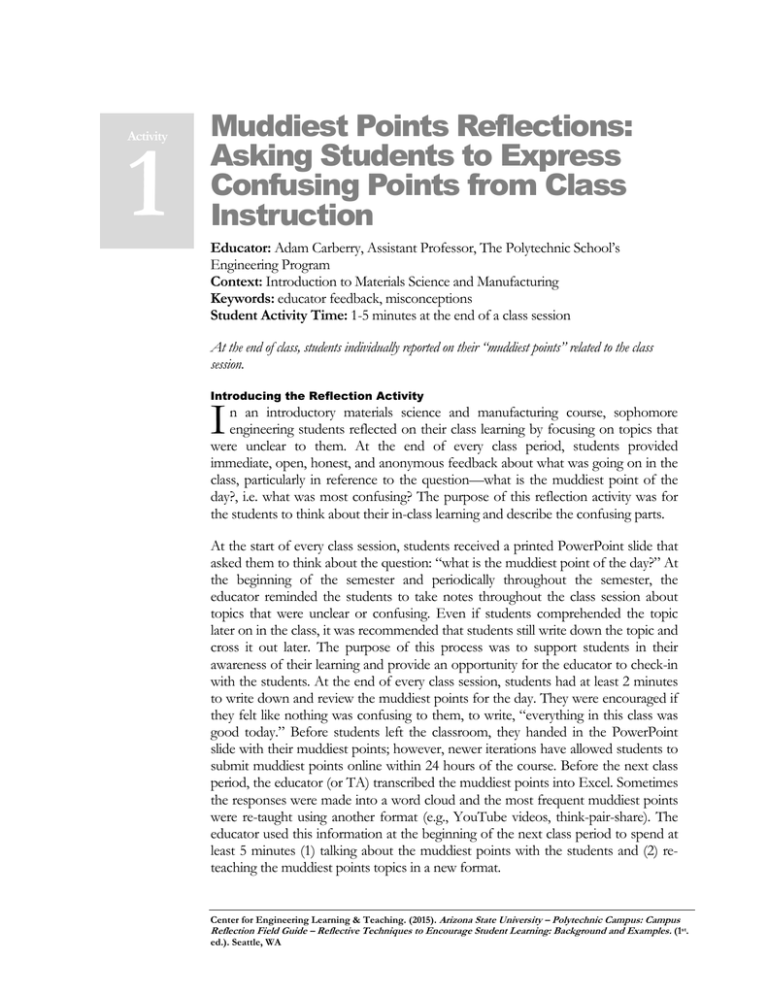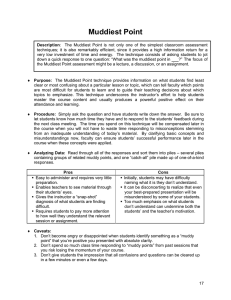Muddiest Points Reflections: Asking Students to Express Confusing
advertisement

Activity 1 Muddiest Points Reflections: Asking Students to Express Confusing Points from Class Instruction Educator: Adam Carberry, Assistant Professor, The Polytechnic School’s Engineering Program Context: Introduction to Materials Science and Manufacturing Keywords: educator feedback, misconceptions Student Activity Time: 1-5 minutes at the end of a class session At the end of class, students individually reported on their “muddiest points” related to the class session. Introducing the Reflection Activity I n an introductory materials science and manufacturing course, sophomore engineering students reflected on their class learning by focusing on topics that were unclear to them. At the end of every class period, students provided immediate, open, honest, and anonymous feedback about what was going on in the class, particularly in reference to the question—what is the muddiest point of the day?, i.e. what was most confusing? The purpose of this reflection activity was for the students to think about their in-class learning and describe the confusing parts. At the start of every class session, students received a printed PowerPoint slide that asked them to think about the question: “what is the muddiest point of the day?” At the beginning of the semester and periodically throughout the semester, the educator reminded the students to take notes throughout the class session about topics that were unclear or confusing. Even if students comprehended the topic later on in the class, it was recommended that students still write down the topic and cross it out later. The purpose of this process was to support students in their awareness of their learning and provide an opportunity for the educator to check-in with the students. At the end of every class session, students had at least 2 minutes to write down and review the muddiest points for the day. They were encouraged if they felt like nothing was confusing to them, to write, “everything in this class was good today.” Before students left the classroom, they handed in the PowerPoint slide with their muddiest points; however, newer iterations have allowed students to submit muddiest points online within 24 hours of the course. Before the next class period, the educator (or TA) transcribed the muddiest points into Excel. Sometimes the responses were made into a word cloud and the most frequent muddiest points were re-taught using another format (e.g., YouTube videos, think-pair-share). The educator used this information at the beginning of the next class period to spend at least 5 minutes (1) talking about the muddiest points with the students and (2) reteaching the muddiest points topics in a new format. Center for Engineering Learning & Teaching. (2015). Arizona State University – Polytechnic Campus: Campus Reflection Field Guide – Reflective Techniques to Encourage Student Learning: Background and Examples. (1st. ed.). Seattle, WA In terms of outcomes, in reflecting every class session on their learning, there was potential for students to have a greater awareness and internalization of the class topics. These reflection activities helped the educator check-in after every class session with the students. In doing so, the educator had an opportunity in the next class session to re-teach course content that was particularly muddy for a number of students. By asking students to keep track of their comprehension, and reflect on their learning, there was potential for students to be more engaged in their learning process, and take a more personal interest in topics covered. It also allowed and encouraged the instructor to continually improve the course. Recreating the Reflection Activity D I G I T A L L I B R A R Y C O N T E N T 1.1 Muddiest Points Instructions Slide 1.2 Processing Muddiest Points Results Spreadsheet Description Explain in the first class session the purpose of the muddiest point reflections. 1 2 3 4 5 6 Hand out the muddiest point reflection PowerPoint slide at the beginning of every class period. Give students at least 2-3 minutes at the end of each class period to fill out the muddiest point reflection PowerPoint slide. Collect all muddiest point PowerPoint slides at the end of the class period. Transcribe all muddiest point reflections into Excel, and then create a visual representation (e.g., word cloud). Use a different teaching approach to present and re-teach the topic(s) that were muddiest. In the words of the Educator: Tips and Tricks Be aware that this “just in time” approach to teaching is time sensitive. This reflection activity requires you, as an educator, to respond to the students’ feedback immediately. There is a definite effort on the side of the educator to make sure that you compile and look at what the students write immediately after they give you those responses. The key to this reflection activity is that I’m telling them to give me feedback and I am responsive to this feedback—“just in time” teaching with formative feedback. By using this “just in time” approach to teaching, my teaching approach can be flexible and dynamic to students’ current needs. Stress the importance and rationale for these daily muddiest points reflections. If you help students see the relevance to their learning, they will be more motivated to provide feedback. You have to stress the importance of their input—their input will impact the class they are taking. Things that will affect them individually and personally are things that are going to interest them and encourage them to want to take the time to do it. Center for Engineering Learning & Teaching. (2015). Arizona State University – Polytechnic Campus: Campus Reflection Field Guide – Reflective Techniques to Encourage Student Learning: Background and Examples. (1st. ed.). Seattle, WA What was the inspiration for the reflection activity? A key part of my teaching philosophy is a commitment to making my classes more interactive. This class in particular, is a little more technical in nature which lends itself to traditional lectures. So, I purposefully try to make the class just a little more active—one way is through these muddiest point reflections. Years ago, at an engineering education conference, I met a professor—Steven Krause— from my current institution (ASU)—and we discussed this teaching approach. I always thought it was interesting. When I started teaching at ASU, I contacted Steve because I knew he was teaching a similar course on the Tempe campus. It was a perfect time to try this approach. Center for Engineering Learning & Teaching. (2015). Arizona State University – Polytechnic Campus: Campus Reflection Field Guide – Reflective Techniques to Encourage Student Learning: Background and Examples. (1st. ed.). Seattle, WA


